Introduction: The Allure of Turkish Borek
Few dishes embody the spirit of Turkish cuisine as perfectly as borek. This flaky, savory pastry has transcended time, evolving through centuries of culinary tradition. Whether served at an elegant gathering or enjoyed as a comforting homemade snack, börek unites food lovers with its irresistible layers of crispy yufka dough and delectable fillings.
In this post, we’ll explore the fascinating history of borek, uncover its regional varieties, and I’ll share my favorite recipes to try at home. They all are true showstopper, guaranteed to become a favorite in your kitchen. Let’s dive in!
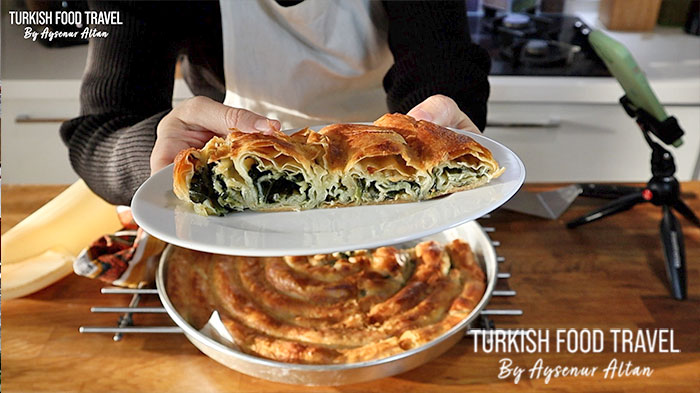
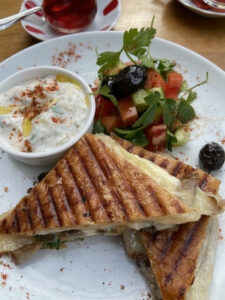
Turkish borek can also be consumed as street food in Türkiye, similar to simit. “Çengelköy Börekçisi” is one of the popular Turkish borek shops in Istanbul. In one of my vlogs about Istanbul food, I visited the Çengelköy Börekçisi shop. Along with all of the classic borek varieties, they also try different unique borek types like borek toast: Crispy toasted borek with cheese filling.
The Origins and History of Börek
Borek traces its roots to the Ottoman Empire, where it became a staple of palace cuisine. The word “börek” originates from the Turkish verb bürmek, meaning “to twist” or “to wrap,” reflecting the pastry’s rolled or folded nature. Over time, börek spread across the Balkans, Middle East, and Central Asia, gaining unique flavors and forms in each region.
Origins in Central Asia
Börek’s roots trace back to the Turkic nomads of Central Asia, who made simple layered pastries using dough and dairy products. These early versions of börek were cooked on a saç (a convex griddle) or in tandoor-like ovens.
Seljuk and Early Anatolian Influence
As the Seljuks migrated into Anatolia in the 11th century, they brought their culinary traditions, including early forms of börek. The dough-making techniques and fillings evolved with local Anatolian ingredients, incorporating cheese, herbs, and meat.
Ottoman Empire and the Golden Age of Börek
Börek flourished during the Ottoman Empire (1299–1922). The imperial kitchens of Topkapı Palace refined and expanded its varieties, turning it into a gourmet dish. Ottoman chefs created delicate, paper-thin yufka (pastry sheets) and filled them with diverse ingredients, such as minced meat, spinach, and feta cheese.
During this time, börek spread across the vast Ottoman territories, influencing Balkan, Middle Eastern, and North African cuisines.
Börek in the Republican Era and Modern Turkey
Following the collapse of the Ottoman Empire, börek remained a significant part of Turkish cuisine. Today, it is enjoyed in homes, bakeries, and street food stalls across Turkey. Modern variations include oven-baked, pan-fried, or deep-fried börek, with countless regional specialties.
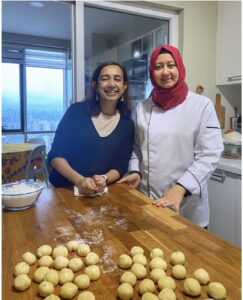
Regional Varieties of Borek in Turkey
Turkey’s diverse geography has given rise to numerous börek varieties, each reflecting the flavors of its region:
- Istanbul: Su Boreği
Known as a “water borek” Su Böreği, is a traditional Turkish borek that resembles lasagna due to its unique preparation method. Unlike other börek types, the yufka sheets are briefly boiled before being layered with cheese, butter, and sometimes minced meat. These layers are then baked until golden brown, resulting in a soft, moist interior and a crispy top.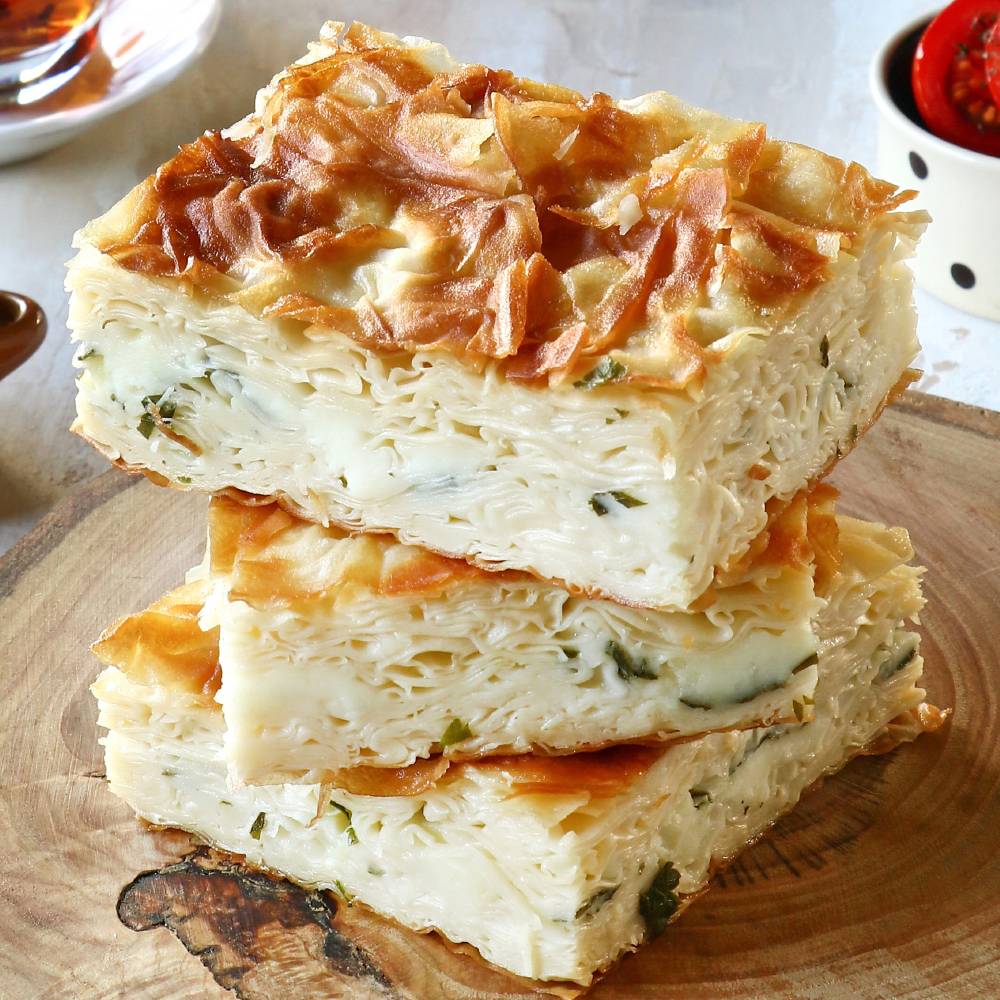
- Aegean Region: Lorlu Borek
Lorlu Börek is a simple yet delicious Turkish pastry made with lor cheese, a mild and slightly crumbly cheese similar to ricotta. It is often combined with fresh herbs like parsley or dill for extra flavor. This type of börek can be baked or fried and is commonly prepared in a tray (tepsi böreği) or as small, rolled pastries (sigara böreği).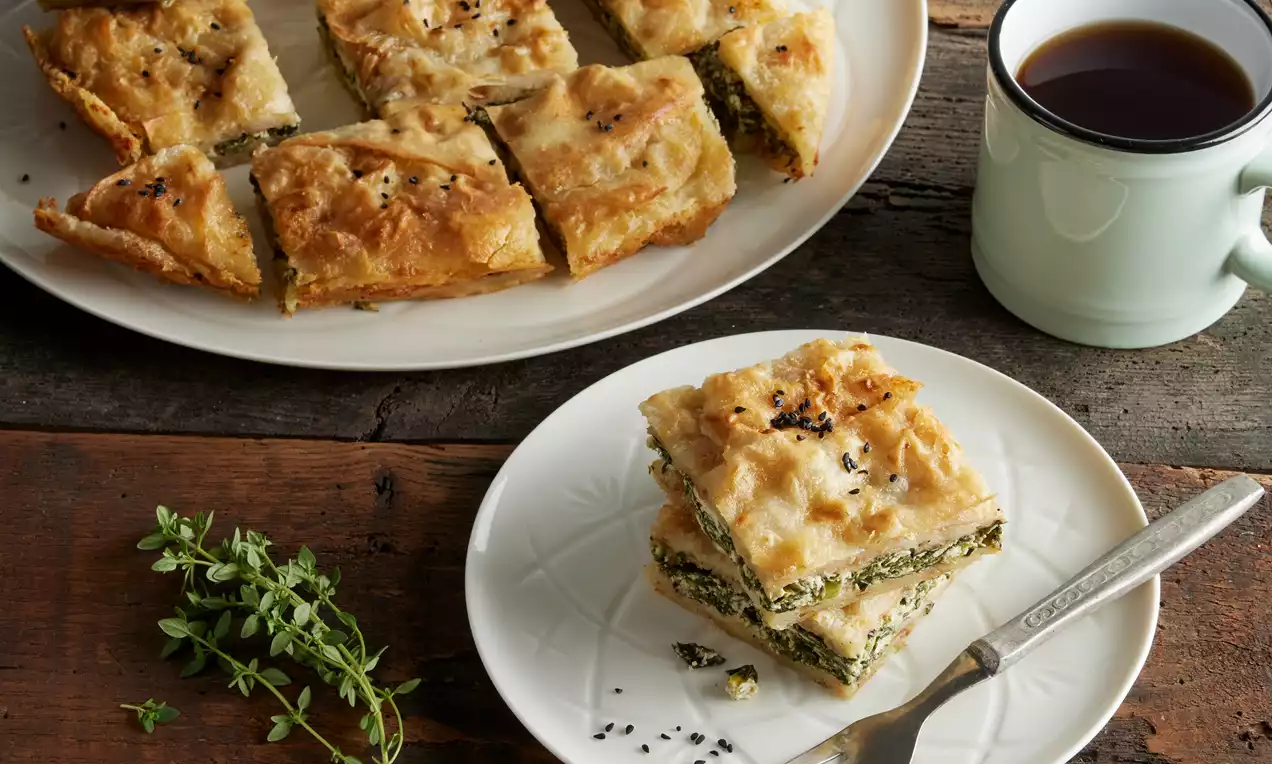
- Anatolia: Kol Boreği
Kol Böreği is a popular Turkish borek known for its long, rolled shape, resembling an “arm” (kol in Turkish). It is made by filling yufka sheets with ingredients like minced meat, spinach, or cheese, rolling them into long cylinders, and then coiling or arranging them in a baking tray.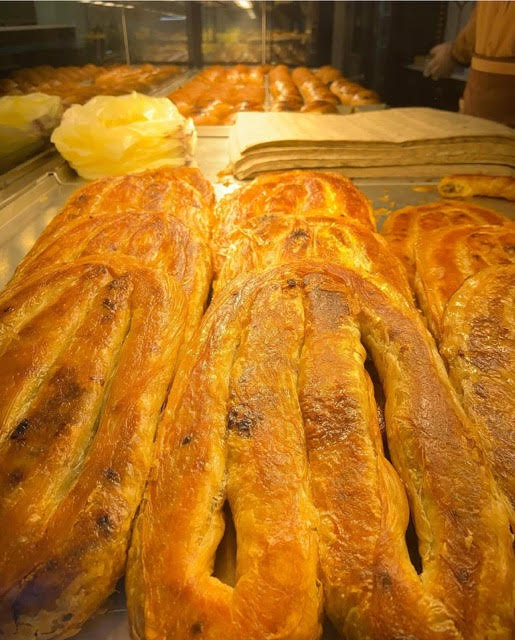
- Black Sea Region: Laz Boreği
Laz Böreği is a traditional dessert from Turkey’s Black Sea region, especially among the Laz people. Despite its name, it’s a sweet pastry made with crispy layers of phyllo dough filled with a creamy custard, then baked and soaked in sugar syrup. It resembles baklava but with a smooth, pudding-like filling instead of nuts.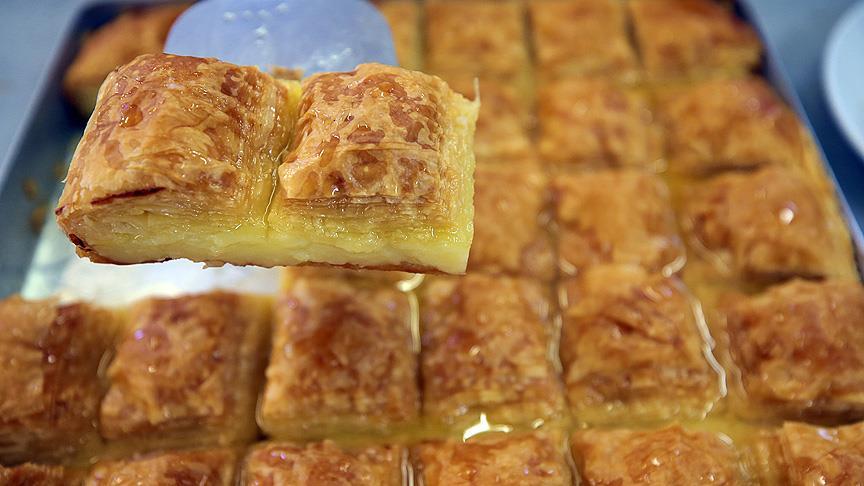 It’s a regional specialty from Rize, Artvin, and Trabzon, offering a delicious mix of crispy and creamy textures.
It’s a regional specialty from Rize, Artvin, and Trabzon, offering a delicious mix of crispy and creamy textures. - Eastern Turkey: Tava Boreği
Tava Böreği is a quick and easy Turkish borek that is cooked in a pan (tava) instead of being baked in oven or fried in deep oil. It is made by layering yufka sheets with a filling, such as cheese, spinach, or minced meat, and cooking it over low heat with a bit of oil or butter until both sides are golden and crispy.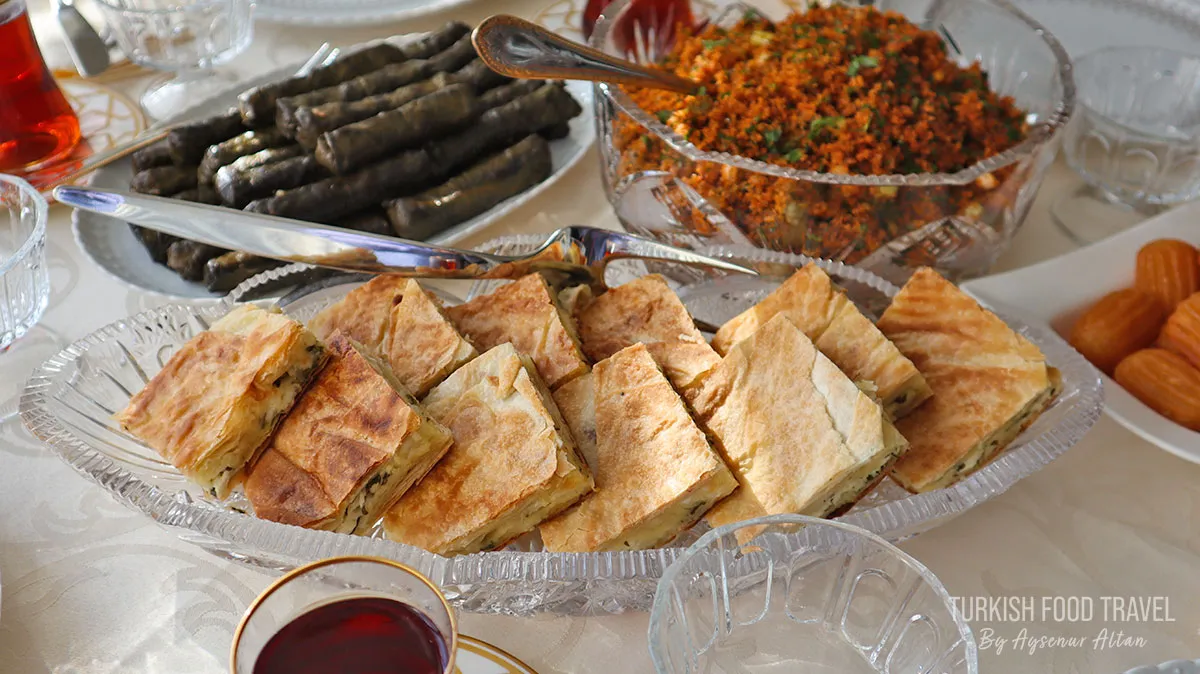
Vegeterian Borek Types
Borek is a beloved Turkish pastry made with thin layers of yufka (phyllo dough) and various fillings, baked or fried to perfection. While traditional borek often includes meat, there are many delicious vegetarian varieties like “Peynirli Borek”, “Ispanaklı Borek”, “Pırasalı Borek” etc. Lentil Bukme, which is a type of vegetarian pastry and belongs to the Afyon region, is one of our recipes that vegetarians can also consume.
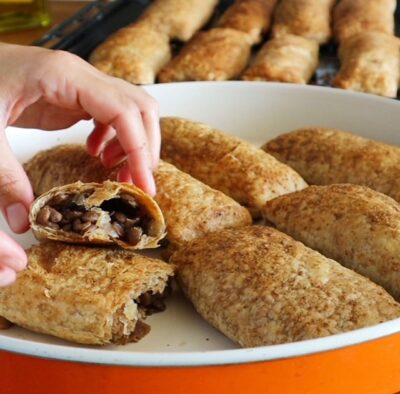
Afyon Bukme is a traditional Turkish flaky pastry filled with spiced green lentils. The dough, made with flour, water, yogurt, and salt, is layered with butter, oil, or poppy seed paste for extra flakiness. This regional specialty is known for its crispy texture and rich, nutty flavor.
The most viewed borek recipe on my site is the one I cook in a pan on the stove in 15 minutes! Let’s take a look at its recipe in detail!
Borek Recipe In 15 Minutes
I am going to show you how you can make Turkish borek with ready yufka sheets or phyllo sheets or even make your own in an easy method. We are going to use only a rolling pin, and will cook on stove-top 5-10 of them together!
Ingredients For Turkish Borek Recipe:
- About 300-350 gr. thick phyllo sheets, yufka sheets. To make your own yufka phyllo sheets please visit this link https://youtu.be/G1SnO65rS48 )
- 1 egg
- 1/3 cup milk
- 1/3 cup vegetable oil
- pinch of salt
- For the filling:
- About 200gr. Turkish white cheese or feta cheese (You can mix it with some shredded mozzarella as well)
- tbsp of chopped parsley
- vegetable oil or butter to cook
- 22-24 cm nonstick pan
You can double the amounts and make a borek in a larger pan about 32cm in diameter. Or triple the amounts and make it in an oven tray and bake it in the oven. Here is the one I made using ready yufka sheets: https://youtu.be/jym9yvHVqMc
Prepare The Sauce And The Filling:
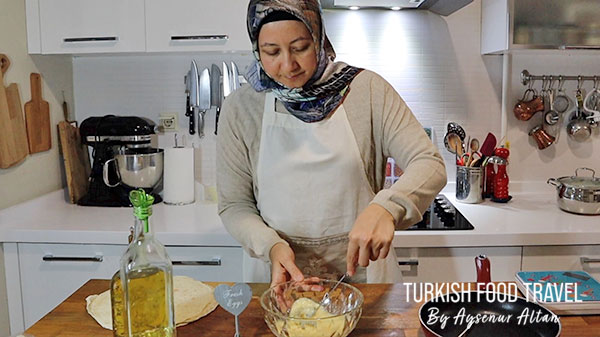
- To make the borek sauce: In a medium size bowl, crack an egg. Add milk, vegetable oil and a pinch of salt. Mix everything well.
- To make the filling: In a medium size bowl crumble white cheese or feta cheese. If you are using mozzarella, grate and add it to the mixture along with chopped parsley and mix well.
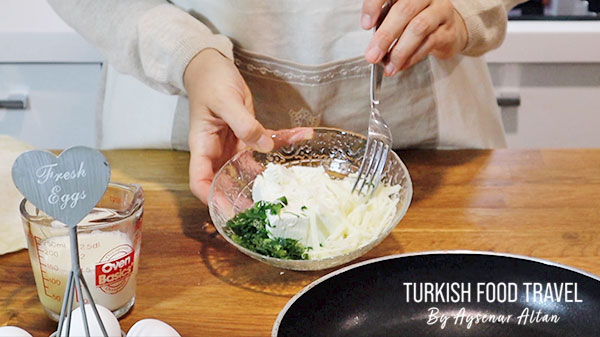
Assembling The Borek:
If you are using ready phyllo or yufka sheets:
- The ready yufka / phyllo sheets are bigger in size. So for 300-350gr you will probably be using 3 yufka sheets. In a nonstick or cast iron about 22-24cm in diameter pan, place one covering the bottom and the sides of the pan and hang the rest from the sides. After we fill inside the borek we will close on top to cover it.
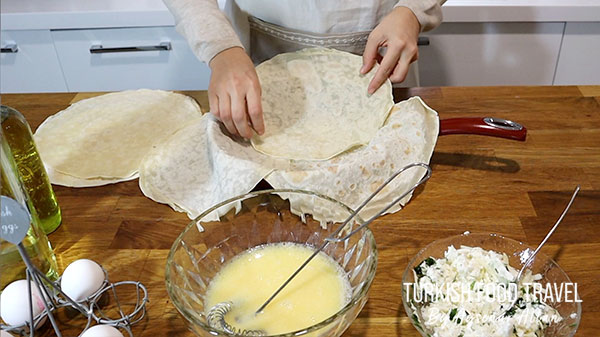
- Place the second one wrinkling so it can fit to the pan. This way it will create air pockets while keeping the sauce we are going to pour. Drizzle almost the half of the sauce over the yufka to dampen.
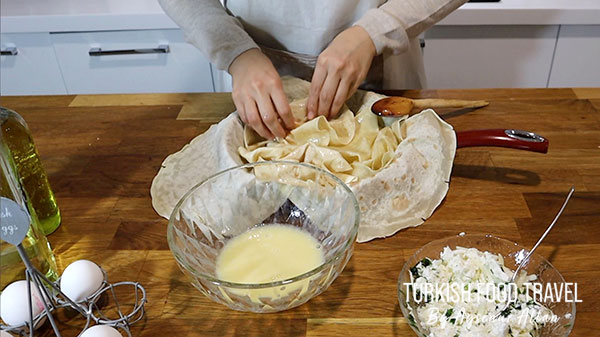
- Add the filling evenly over the wet yufka sheet. Add the third sheet wrinkling and covering the cheese filling. Drizzle from the sauce and cover the hanging yufka pieces over and lightly wet between the overlapping sheet.
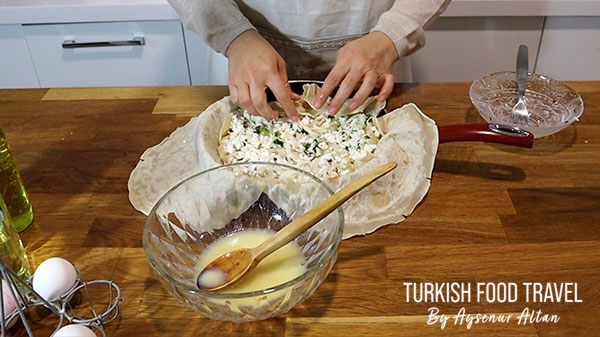
Don’t use the sauce on top of the borek since it can stick while cooking. Pour the leftover sauce inside if you have and (watch the video:)
If you make it with homemade yufka sheets or frozen thick phyllo sheets:
Cover the bottom and the sides with 3 small sheets hanging form the sides and begin to build inside. With the same method make the first layer of your borek placing sheets wrinkled. You may use 3-4 sheets or more to build one layer. Drizzle half of the sauce and place the filling and continue to the same steps above.
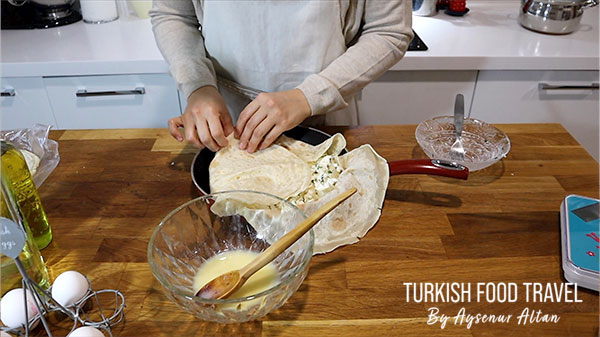
Baking The Borek:
After assembling the borek, bake in low medium heat, closing lid until bottom is golden brown. You can check after delicious smells coming from your borek. Using a flat lid or plate that can fit inside your pan flip the borek and cook the other side. It should take at least about 15 minutes to cook, so inside can fully set. After 15 minutes, my borek is cooked.
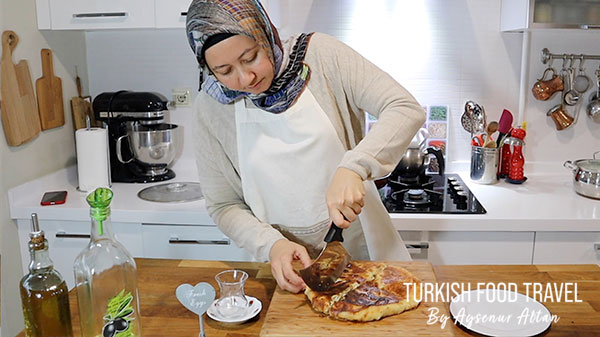
Enjoy your crispy borek best while it is still warm with Turkish tea. Perfect for anytime of the day, expecially for breakfast or with afternoon tea time. Keep the leftover borek pieces in the fridge in a container (you can freeze it too) and reheat the next day in a pan with lid, heating both sides until crispy again.
Common Mistakes When Making Turkish Borek
- Not moistening the yufka properly: Dry yufka results in a tough texture; always use a mixture of milk, eggs, or oil to keep it moist. Below you can see my own yufka dough. Instead of ready-made yufka dough, you can also make “tava borek” with yufka dough that you make yourself.

- Overstuffing the filling: Adding too much filling can cause börek to break apart or not cook evenly.
- Not sealing the edges well: This can lead to the filling leaking out, especially in fried börek.
- Incorrect baking temperature: Too high can burn the top while leaving the inside raw, and too low can make it soggy.
- Skipping the resting step after baking: Allowing börek to rest for 5-10 minutes helps it set and makes slicing easier.
Key Tips for Delicious Turkish Borek
- Always brush each layer of yufka with oil or a milk-based mixture to achieve a crispy and flaky texture.
- Use fresh, high-quality ingredients for the filling to enhance flavor.
- Let börek rest before slicing to maintain its shape and texture.
- Experiment with different fillings such as mushrooms, chicken, or mixed vegetables for variety.
- For an extra crispy top, brush the final layer of yufka with egg yolk before baking.
What to Serve with Turkish Borek?
In Turkey, börek is commonly served with Turkish tea (çay) or ayran, both of which complement its rich and savory flavors. I have a detailed video about Turkish tea on my YouTube channel. You can watch for details.
- Turkish Tea (Çay): Turkish people consider çay (Turkish tea) a staple of their culture. They brew this strong black tea in a double teapot (çaydanlık) and serve it in small tulip-shaped glasses. With its deep red color, people enjoy it plain or with sugar, making it a perfect companion to börek, especially during breakfast or tea time.

- Ayran: A refreshing yogurt-based drink made by mixing yogurt, water, and a pinch of salt. Ayran has a creamy texture and a slightly tangy taste, balancing the richness of börek. It is particularly popular with savory börek varieties, such as those filled with minced meat or spinach.
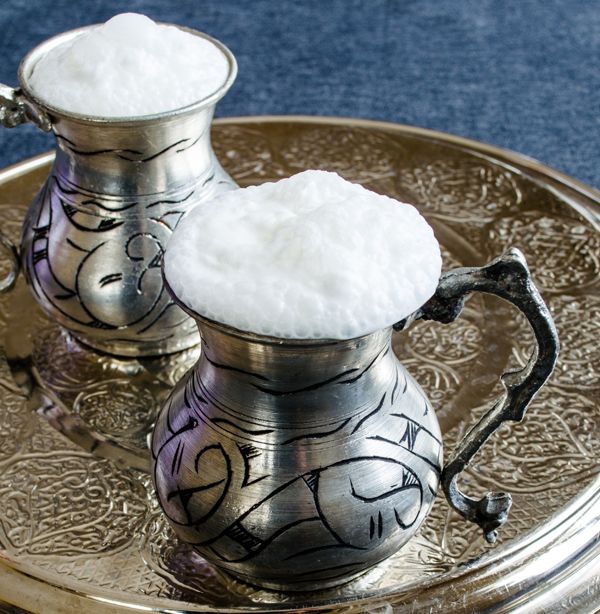
Both drinks are essential parts of Turkish culinary tradition and enhance the enjoyment of börek!
How to Store, Freeze and Reheat Turkish Borek?
Freshly baked borek stays fresh at room temperature for up to 12 hours if covered to prevent drying out. For longer storage, place it in an airtight container and keep it in the refrigerator for up to 3-4 days.
To freeze Turkish borek, you can store it either baked or unbaked. If freezing it unbaked, assemble it as usual but do not bake. First, freeze it on a tray for about 1-2 hours until it firms up, then transfer it to a freezer bag or airtight container. This method keeps it fresh for up to three months. When you freezing it after baking, let it cool completely, cut it into portions, wrap them tightly in plastic wrap or foil, and store them in the freezer for the same duration.
To reheat borek, follow different steps depending on how you stored it. When you refrigerated, warm it in a preheated oven at 180°C (350°F) for about 10-15 minutes until it turns crisp. If frozen and unbaked, put it directly into the oven at the same temperature and bake for 40-50 minutes. When you froze it after baking, reheat it for 15-20 minutes in the oven to restore its texture. Avoid using a microwave, as it makes börek soggy instead of crispy.
You can also check out my other pastry recipes on my site and channel.
- Turkish Borek For Lazy Afternoon: Amazing Result
- 2 Ingredient Easy Turkish Borek
- Mastering Homemade Turkish Spinach Börek Pastry – Easy Rolling Pin Method for Beginners
- Mastering the Art of Borek: 8 Recipes You NEED to Try!
Börek is more than just a pastry—it is a culinary tradition that has stood the test of time, evolving from its humble Central Asian origins to become a cherished dish in Turkish cuisine. With its countless variations, from crispy sigara böreği to the rich and layered su böreği, it reflects the diversity and creativity of Turkish cooking. Whether made with homemade yufka or store-bought sheets, börek remains a staple in Turkish households, perfect for breakfast, tea time, or special gatherings.
By mastering the art of börek-making and avoiding common mistakes, anyone can recreate this iconic dish at home. Whether you prefer a simple cheese-filled börek or a more elaborate version with homemade dough, the key is patience, quality ingredients, and a love for tradition. No matter how it is prepared, börek continues to bring people together, one delicious bite at a time.

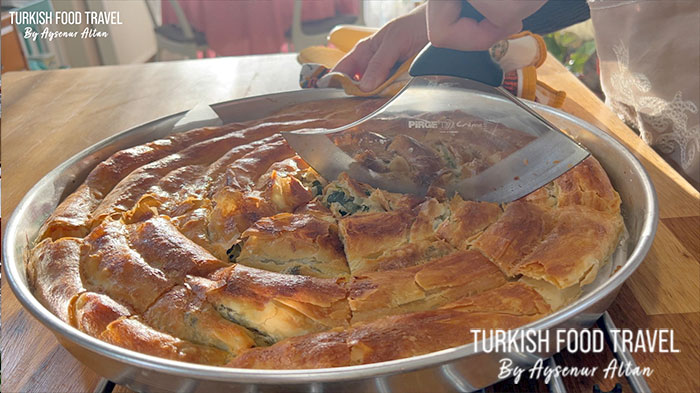
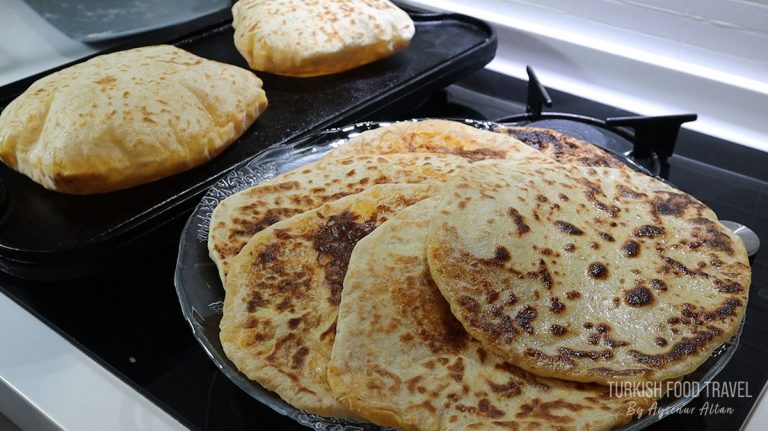
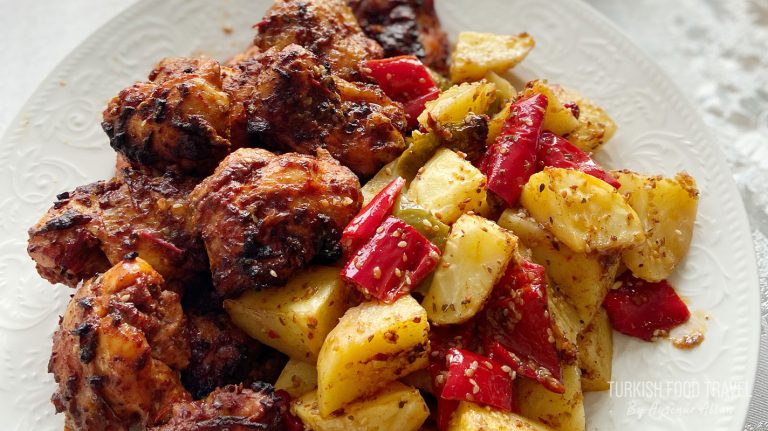
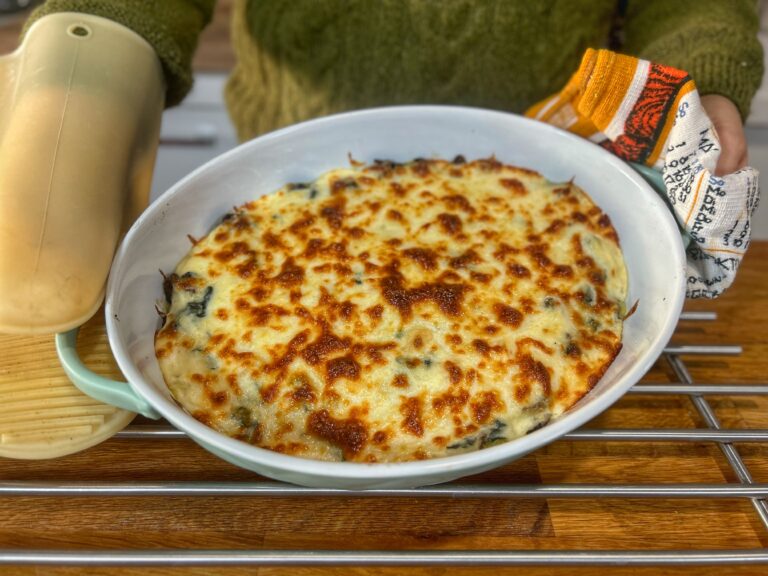
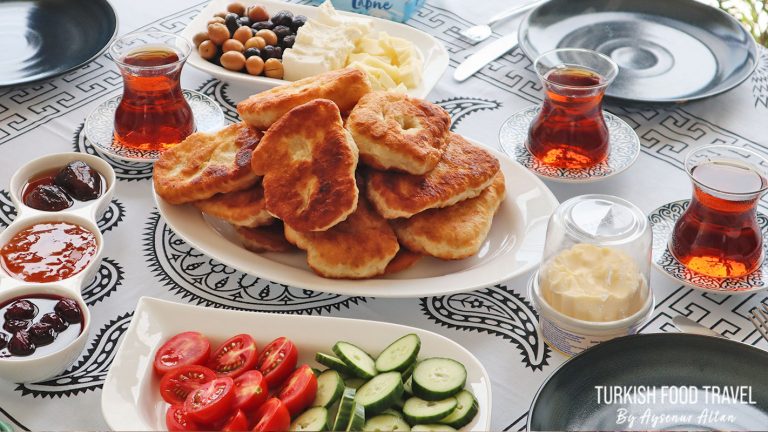
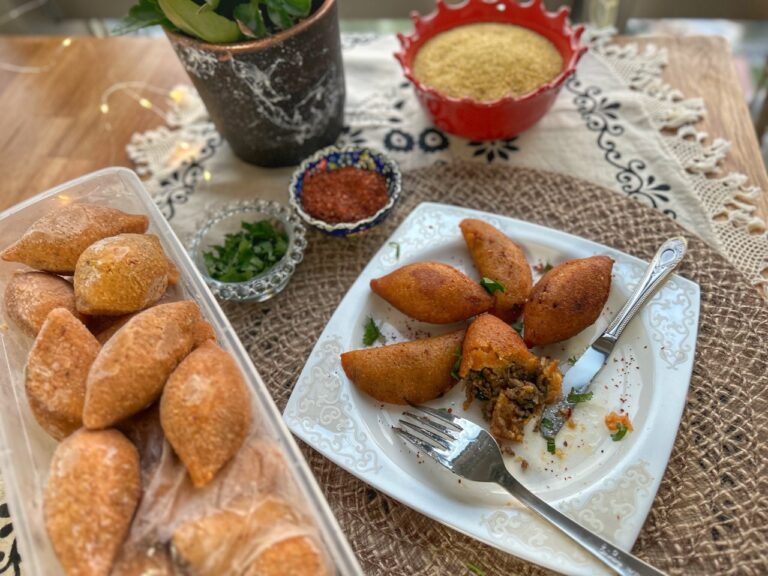
4 Comments